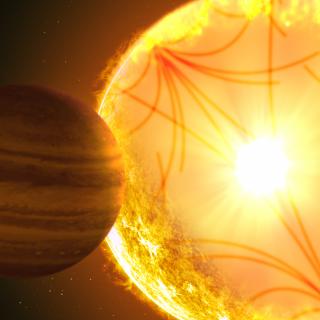Bibcode
Bugnet, L.; García, R. A.; Davies, G. R.; Mathur, S.; Corsaro, E.; Hall, O. J.; Rendle, B. M.
Bibliographical reference
Astronomy and Astrophysics, Volume 620, id.A38, 9 pp.
Advertised on:
11
2018
Journal
Citations
38
Refereed citations
34
Description
Asteroseismology provides global stellar parameters such as masses,
radii, or surface gravities using mean global seismic parameters and
effective temperature for thousands of low-mass stars (0.8
M⊙ < M < 3 M⊙). This methodology has
been successfully applied to stars in which acoustic modes excited by
turbulent convection are measured. Other methods such as the Flicker
technique can also be used to determine stellar surface gravities, but
only works for log g above 2.5 dex. In this work, we present a new
metric called FliPer (Flicker in spectral power density, in opposition
to the standard Flicker measurement which is computed in the time
domain); it is able to extend the range for which reliable surface
gravities can be obtained (0.1 < log g < 4.6 dex) without
performing any seismic analysis for stars brighter than Kp < 14.
FliPer takes into account the average variability of a star measured in
the power density spectrum in a given range of frequencies. However,
FliPer values calculated on several ranges of frequency are required to
better characterize a star. Using a large set of asteroseismic targets
it is possible to calibrate the behavior of surface gravity with FliPer
through machine learning. This calibration made with a random forest
regressor covers a wide range of surface gravities from main-sequence
stars to subgiants and red giants, with very small uncertainties from
0.04 to 0.1 dex. FliPer values can be inserted in automatic global
seismic pipelines to either give an estimation of the stellar surface
gravity or to assess the quality of the seismic results by detecting any
outliers in the obtained νmax values. FliPer also
constrains the surface gravities of main-sequence dwarfs using only
long-cadence data for which the Nyquist frequency is too low to measure
the acoustic-mode properties.
Related projects

Helio and Astero-Seismology and Exoplanets Search
The principal objectives of this project are: 1) to study the structure and dynamics of the solar interior, 2) to extend this study to other stars, 3) to search for extrasolar planets using photometric methods (primarily by transits of their host stars) and their characterization (using radial velocity information) and 4) the study of the planetary
Savita
Mathur